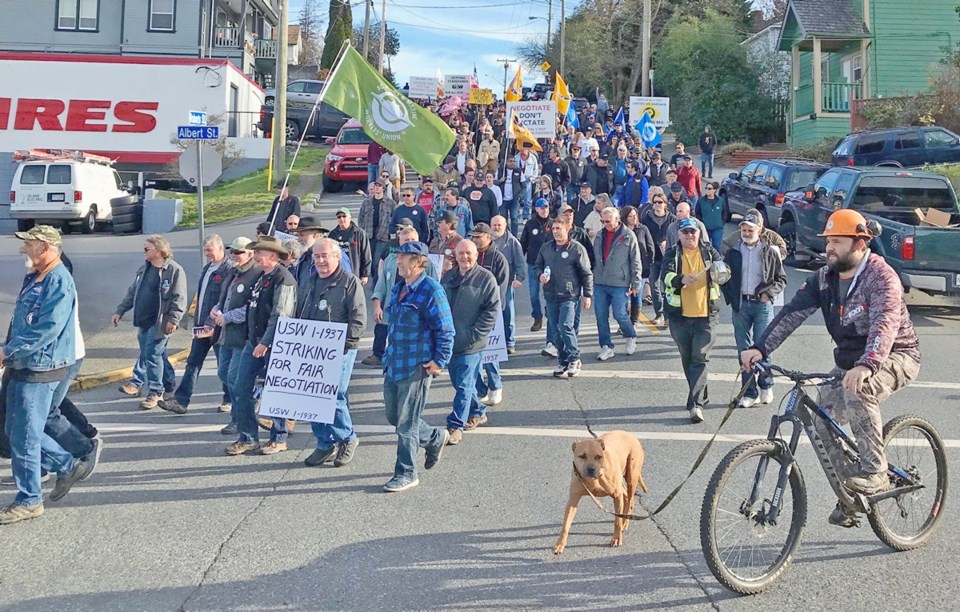With the seven-month WFP strike dragging on up-Island and forest-industry towns everywhere on their knees, this might not seem an ideal time to urge British Columbians to rally against old-growth logging.
But with just a week to go before the next deadline in a provincial government review process, Jens Wieting doesn’t have much choice.
As it is, the Sierra Club of B.C.’s senior forest and climate campaigner already worries time is slipping away, with the province’s oldest trees falling at a rapid pace as the authorities ponder what to do.
“Talk and log,” he calls it.
Nor does he see a contradiction in fighting for old growth at a time when forest jobs are disappearing.
“The forestry jobs crisis makes it more difficult for government to protect more forests, but logging the last unprotected old-growth is arguably not sustainable,” he says. “Once gone, it will only be more difficult to create alternative jobs in a diverse economy in sectors like tourism and recreation. It is time for the B.C. government to accept that business as usual is not going to end well, either for ecosystems or forestry jobs.”
So, he’s calling on people to make sure they’re heard prior to the Jan. 31 deadline for public input into the Old Growth Strategic Review that the province announced in July. A two-member panel is to make recommendations to the government this spring (for more information, go to engage.gov.bc.ca/oldgrowth).
If a poll commissioned by the Sierra Club of B.C. is an indicator, the public is solidly onside: 92 per cent of those surveyed (including 87 per cent on northern Vancouver Island) favoured protection for old-growth forests.
Easier said than done, though. Even if B.C. were to transition away from logging old growth, Wieting says, it couldn’t be done in a day.
Some steps should be immediate, though, he argues.
First, he says, interim protection is needed for all remaining intact old-growth forests, such as the central Walbran Valley northwest of Port Renfrew and rare inland rainforests in the B.C. Interior.
The province must also bring in immediate protection of the most-endangered old-growth ecosystems, Wieting said. They must be restored to the point that they can sustain the web of life that is already unravelling.
It is critical, Wieting says, to retain intact old-growth forests as a buttress against climate change.
“The bushfires in Australia are another reminder that we are in the midst of an extinction and climate crisis that will only get worse unless our governments have the courage to change course. This must include protection of B.C.’s endangered carbon-rich old-growth forests, which are also the most resilient forests with the best potential to protect communities from climate-change impacts like drought and flooding and are least prone to fire.”
The alternative, continued global warming, means no forests will be able to survive in their current form, he said. “Protecting old growth is one of the steps we need to protect our economy, including forestry jobs, in the future.”
The opposing argument includes figures showing 55 per cent of coastal old-growth rainforests are already protected, but environmentalists say that’s misleading. The percentage refers only to the protected portion of the forest that remains standing, not what was there in the first place. On Vancouver Island, for example, the Sierra Club of B.C. estimates only one-fifth of the original, productive old-growth forest still stands.
We have been told, repeatedly, that there is urgency to this. Two years ago, 223 international scientists signed a letter saying that for the sake of climate change, biodiversity, human health and drinking water, it was critical to save Vancouver Island’s remaining temperate rainforests, as well as those on the south coast, the windward side of the Rockies and the Columbia mountain ranges in southeastern B.C., right now.
Speaking of trees (in a wholly unrelated way), Winston Churchill once planted one in Beacon Hill Park. The somewhat scraggly yew has stood in the Mayor’s Grove near Southgate and Quadra since 1929.
It doesn’t look 90, but then neither does the equally scraggly Les Leyne, who hosts a brief gathering of Churchill fans at the base of the tree each year around the anniversary of Sir Winston’s death.
This year’s event will be at 2 p.m. Sunday. As usual, it will feature a few words, a toast and an appearance by the great man himself (that’s Churchill, not Les, though he’ll be there, too).



